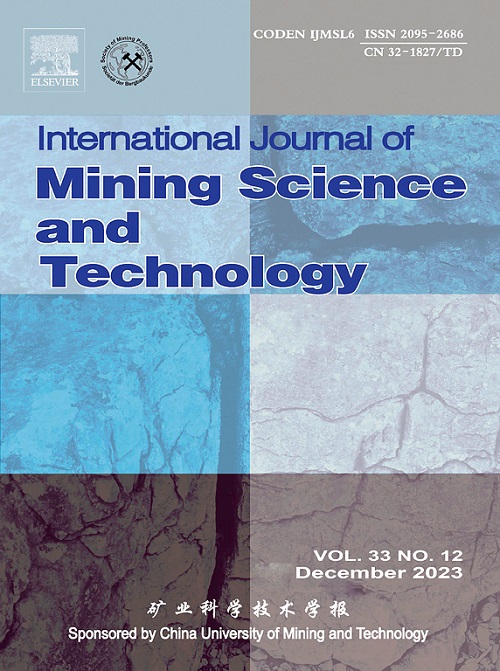Shear damage constitutive model of rock-like joint surface considering the coupling effect of cyclic water intrusion and loading
IF 13.7
1区 工程技术
Q1 MINING & MINERAL PROCESSING
International Journal of Mining Science and Technology
Pub Date : 2025-06-01
DOI:10.1016/j.ijmst.2025.05.001
引用次数: 0
Abstract
Prolonged cyclic water intrusion has progressively developed joints in the hydro-fluctuation belt, elevating the instability risk of reservoir bank slopes. To investigate its impact on joint shear damage evolution, joint samples were prepared using three representative roughness curves and subjected to direct shear testing following cyclic water intrusion. A shear damage constitutive model considering the coupling effect of cyclic water intrusion and load was developed based on macroscopic phenomenological damage mechanics and micro-statistical theory. Results indicate: (1) All critical shear mechanical parameters (including peak shear strength, shear stiffness, basic friction angle, and joint compressive strength) exhibit progressive deterioration with increasing water intrusion cycles; (2) Model validation through experimental curve comparisons confirms its reliability. The model demonstrates that intensified water intrusion cycles reduce key mechanical indices, inducing a brittle-to-ductile transition in joint surface deformation — a behavior consistent with experimental observations; (3) Damage under cyclic water intrusion and load coupling follows an S-shaped trend, divided into stabilization (water-dominated stage), development (load-dominated stage), and completion stages. The research provides valuable insights for stability studies, such as similar model experiments for reservoir bank slopes and other water-related projects.
考虑循环水侵和荷载耦合效应的类岩节理面剪切损伤本构模型
长期的循环水侵使消落带的节理逐渐发育,增加了库岸边坡的失稳风险。为了研究其对节理剪切损伤演化的影响,采用3条具有代表性的粗糙曲线制备节理试样,并进行了循环水侵后的直剪试验。基于宏观现象学损伤力学和微观统计理论,建立了考虑循环水侵与荷载耦合效应的剪切损伤本构模型。结果表明:①随着水侵循环次数的增加,峰值抗剪强度、抗剪刚度、基本摩擦角、节理抗压强度等关键抗剪力学参数均呈现逐渐恶化的趋势;(2)通过实验曲线对比验证了模型的可靠性。该模型表明,强化的水侵循环降低了节理表面的关键力学指标,导致节理表面变形从脆性向韧性转变,这一行为与实验观察结果一致;(3)循环水侵和荷载耦合作用下的破坏呈s型变化趋势,分为稳定阶段(水主导阶段)、发展阶段(荷载主导阶段)和完井阶段。该研究为稳定性研究提供了有价值的见解,例如对水库岸坡和其他与水有关的工程进行类似的模型实验。
本文章由计算机程序翻译,如有差异,请以英文原文为准。
求助全文
约1分钟内获得全文
求助全文
来源期刊

International Journal of Mining Science and Technology
Earth and Planetary Sciences-Geotechnical Engineering and Engineering Geology
CiteScore
19.10
自引率
11.90%
发文量
2541
审稿时长
44 days
期刊介绍:
The International Journal of Mining Science and Technology, founded in 1990 as the Journal of China University of Mining and Technology, is a monthly English-language journal. It publishes original research papers and high-quality reviews that explore the latest advancements in theories, methodologies, and applications within the realm of mining sciences and technologies. The journal serves as an international exchange forum for readers and authors worldwide involved in mining sciences and technologies. All papers undergo a peer-review process and meticulous editing by specialists and authorities, with the entire submission-to-publication process conducted electronically.
 求助内容:
求助内容: 应助结果提醒方式:
应助结果提醒方式:


